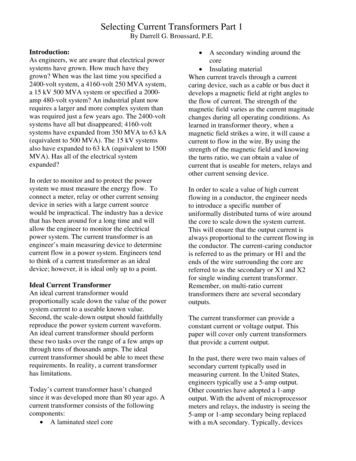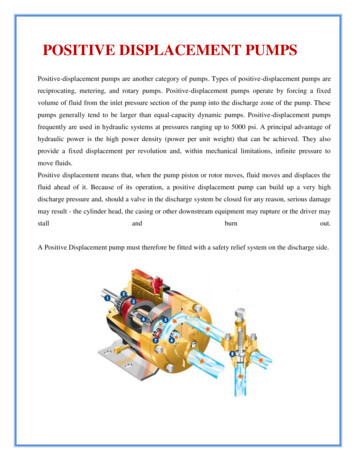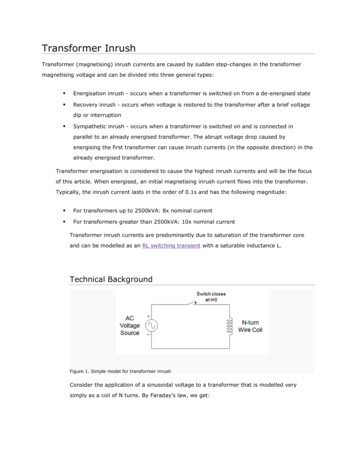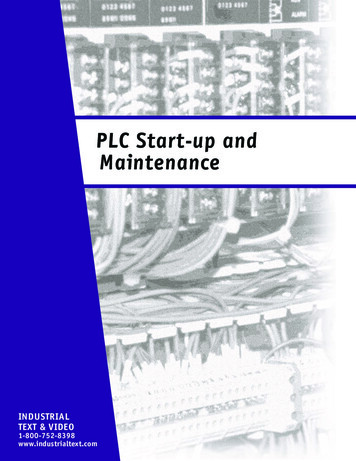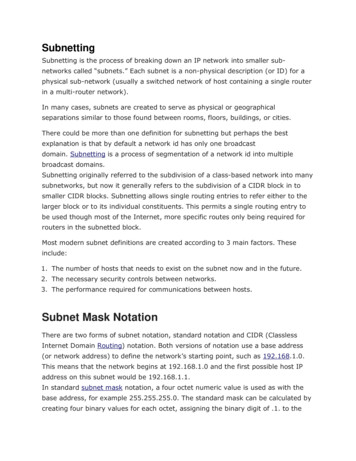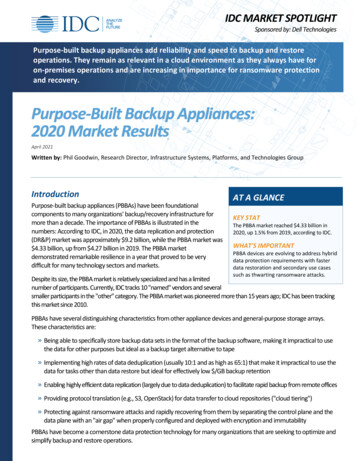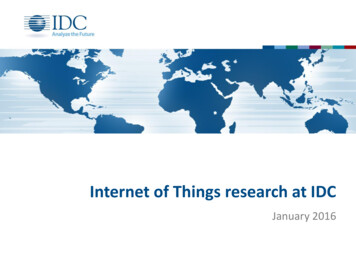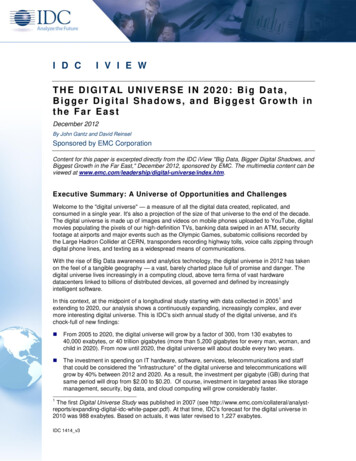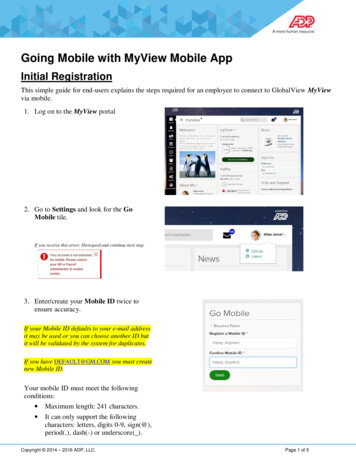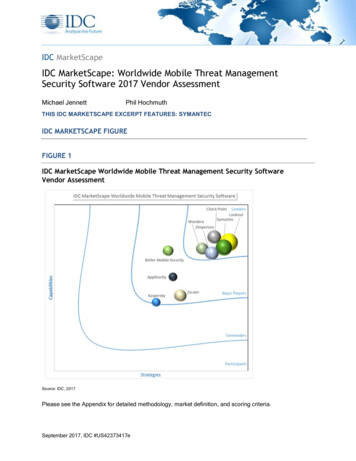
Transcription
IDC MarketScapeIDC MarketScape: Worldwide Mobile Threat ManagementSecurity Software 2017 Vendor AssessmentMichael JennettPhil HochmuthTHIS IDC MARKETSCAPE EXCERPT FEATURES: SYMANTECIDC MARKETSCAPE FIGUREFIGURE 1IDC MarketScape Worldwide Mobile Threat Management Security SoftwareVendor AssessmentSource: IDC, 2017Please see the Appendix for detailed methodology, market definition, and scoring criteria.September 2017, IDC #US42373417e
IN THIS EXCERPTThe content for this excerpt was taken directly IDC MarketScape: Worldwide Mobile ThreatManagement Security Software 2017 Vendor Assessment (Doc # US42373417). All or parts of thefollowing sections are included in this excerpt: IDC Opinion, IDC MarketScape Vendor InclusionCriteria, Essential Guidance, Vendor Summary Profile, Appendix and Learn More. Also included isFigure 1.IDC OPINIONAs the mobility market continues to evolve, we are seeing changes to the way enterprises evaluate thesecurity needs of their enterprise mobility solutions. This has brought about an expansion of mobilethreat management (MTM) products that expand beyond the standard tracking and management ofdevices we have traditionally focused on with enterprise mobility management (EMM).IDC sees the mobile threat management market gaining momentum as more enterprises decide thatEMM/MDM and native sandboxing and segmentation on mobile operating systems (OSs) are notenough to meet overall mobile threat management needs. According to IDC's 2017 U.S. EnterpriseMobility Decision Maker Survey, half of U.S. enterprises and SMBs have deployed some form ofmobile device security solution — mobile antimalware, mobile threat management, or mobile appscanning. An additional one-third of U.S. businesses not using MTM today plan to deploy thistechnology in the future.Deploying EMM plus MTM is becoming the new defense-in-depth, or "belt suspenders," approach tosecurity. Every MTM customer reference IDC interviewed for this study deployed its MTM solution inconcert with EMM technology. This follows the overall trend among U.S. enterprises; among the 50%of enterprises deploying MTM solutions, more than three-quarters also had deployed EMM, accordingto IDC's 2017 U.S. Enterprise Mobility Decision Maker Survey.MTM interest is driven by the overall security challenges businesses face. According to the IDCmobility survey, mobile security/compliance, in general, was the most frequently cited challengebusinesses said they face among all aspects of a mobility deployment — before cost, complexity, andvendor-related issues. Compliance requirements specifically drive a lot of MTM buying decisions, asbusinesses face market/industry-specific compliance requirements and mobile computing, as well asmore broad-sweeping regulatory challenges, such as the General Data Protection Regulation in theEuropean Union (EU), and for firms operating in that region.Key findings of this study include:Vendors' MTM products are primarily focused on iOS and Android platforms with limitedavailability on the Windows 10 platform, with many believing the traditional Windows securityproducts cover that area. This leaves a gap between pure-play mobile devices and enterprisetablet devices utilizing Windows 10 operating system.Capabilities found in most MTM products focus on protecting the device from phishing attacks,man-in-the-middle attacks, and device-specific security issues such as jailbreaking. AdvancedMTM providers cover every aspect of interactions with the mobile device — from userdownloaded apps through to network connections. Thwarting SMS-based attacks is also afocus for MTM providers, as texting is a frequently used business communications tool thatfalls outside the area of most traditional security solutions. 2017 IDC#US42373417e2
Carrier partnerships are key go-to-market strategies for MTM providers as a way to get theirsoftware deployed on enterprise mobile devices provisioned through mobile operators andmanaged via mobile life-cycle management or managed EMM solutions.Similar to carrier partnerships, EMM partnerships are critical for MTM providers in businessdeployments, as most MTM solutions rely on these platforms for a range of remediation anddevice-level enforcement capabilities, as well as distribution of MTM agents to corporate-liableand BYO devices.Customers of MTM software are focused on device management beyond standard EMM andlooking for the next level of security for their enterprise devices.IDC MARKETSCAPE VENDOR INCLUSION CRITERIAVendors included in this research effort meet the following inclusion criteria:Mobile threat management, as defined for the purposes of this vendor assessment, providesprotection, detection, analysis, and remediation of mobile device based on threats from both adevice and a network perspective.Software offering must be standalone or, if not standalone, the products' primary focus mustbe mobile threat management. Offering should have both a client (mobile app) and a networkcomponent that complement each other and provide real-time data for analysis and mitigation.Offering must, at a minimum, support Android- and iOS-based devices.Offering must meet one of the following criteria: offering has been available for at least oneyear, or it must have five or more verifiable customers.ADVICE FOR TECHNOLOGY BUYERSThis study analyzes and rates vendors across a broad range of capability- and strategy-focusedcriteria. As mobile threat management comprises a group of products in a nascent stage, it isimportant to evaluate them based on customer interactions with the available products as well as theseproducts' view to the future of mobility. As threats evolve, so must the road maps of the products thatwill protect devices from these threats. Further as more IoT devices enter the market, it is important forthe interaction between MTM products, enterprise mobile devices, and future devices to all workseamlessly together, which requires MTM products to go beyond traditional mobile device protectionsto take IoT into account. Some of the key areas that IT buyers should focus on when evaluating MTMproducts are discussed here.Key Measures for SuccessCurrent capabilities. Key capabilities match the market need for protection from local physicalattacks, [interactive] network attacks, mobile email attacks, SMS-based attacks, web-basedattacks, app-based attacks, malware compromise, outdated operating systems, jailbreaking,and so forth. IDC believes that when reviewing mobile threat management products,customers should be aware that there are baseline capabilities that are necessary for theseproducts to be functional for the enterprise market. These key capabilities ensure that theproduct goes beyond device management or simple virus scanning and is truly a threatmanagement product that will provide IT organizations with a potent tool to fight mobile threatsin fashion that is not cumbersome to the user. 2017 IDC#US42373417e3
Evolving product road map. The product road map is based on customer and partner input thatcovers the aspects of cloud, data analysis, mobility solutions, and social integration. Theproduct road map shows substantial investment in planning and timing based on inputs fromcustomers and partners as well as an overall understanding of the industry. The road mapextends past basic product functionality and looks to accommodate current mobile deviceofferings and is future looking in a fashion that positions the company and product to be aleader in the industry.Further, the road map shows understanding of how the security market is evolving to addressmobile threat management architecture needs. With mobile security still in its nascent stageand mobile becoming more prevalent in the enterprise, it is imperative that the product roadmap can meet the evolving business needs that companies will be facing over the next fewyears. Having a product that is poised to handle today's security concerns and is looking to thefuture about mobile and IoT is imperative for success.Planned service offerings (products to be introduced next year). Demonstration of productgrowth and expansion meets current and future market needs. In conjunction with the overallstrategic road map, the offerings planned over the next year are important to evaluating eachof these enterprise MTM products. IDC looked at the offerings that are planned as well as whatis currently in testing to determine the product will meet the needs of the enterprise today andwill incorporate the changes in the industry; vendor is actively providing new features to meetthose needs.Customer assessment of vendor. Customers rely on innovative opportunities with vendor forstrategic needs. A key element IDC looks for when evaluating products is how the currentcustomer base feels about that product in its implementation. No matter how many features aproduct has or how long it's been on the market, if it is does not meet the needs of thecustomer or if it is cumbersome for the customer to install, support, or use, it will not beadopted. Therefore, customer success is a key factor in the success of a product. Product isshown to be easy to implement and meets the current and future needs of the customer basein the enterprise market.Further, new security features can be cumbersome and difficult to implement on the enterpriselevel. The ability to deliver product that is easy to implement from the time the customer signs acontract to when the customer has the product up and running is one of the keys to a successfulimplementation. Based both on vendor information and customer impact, IDC evaluated the timerequired to roll out each new product both at the network level and at the device level.Architectural innovation. Strategic plan to make mobile threat management is a key element ofstrategic security architecture. Mobile threats are an ever-growing aspect of the enterprise,and with more mobile devices entering the enterprise arena, it is imperative that mobile threatmanagement products focus on architectural development and innovation that are positionednot just for today's threats but also for tomorrow's threats. A mobile threat managementproduct must be constantly evolving and able to look for the next threat on the horizon ratherthan simply focusing on the threats of today.Implementation. Mobile threat management is just one tool in the security toolbox forenterprise mobility today. For this reason, it is imperative that the MTM tool can easilyintegrate with existing security infrastructure and other security tools. The MTM solution mustintegrate out of the box with current EMM solutions and connect to existing securityinformation and event management (SIEM) products used within the enterprise. The MTMproduct must also be easily installed on all mobile devices that are managed by the enterprisecustomer. Device installation should be simple and straightforward for the users and ensurethat little memory and battery is required for usage. 2017 IDC#US42373417e4
Support. Vendor offers various levels of support, providing customers with the ability to mitigateissues throughout the product life cycle. This can include carrier partnerships to deliver MTMsoftware with business handsets as well as broader integration strategies with systemsintegrators and security solutions implementation partners with mobile-focused practices.As MTM is still a relatively new area for most enterprises, it is important that support is easilyaccessible to the IT organization. We evaluated products based on the level of supportprovided and the extent to which that support is available on a 24 x 7 basis. IDC looked at thesupport offerings of each product based on what was provided by the vendor, how thecustomers currently use support, and customer assessment of support.Intellectual property. To be a true leader in MTM, it is important for the product to go beyondjust basic capabilities. This aspect of capabilities looks at things such as machine learning andAI capabilities within each product. IDC evaluated the unique features and offerings of eachproduct.VENDOR SUMMARY PROFILESThis section briefly explains IDC's key observations resulting in a vendor's position in the IDCMarketScape. While every vendor is evaluated against each of the criteria outlined in the Appendix,the description here provides a summary of each vendor's strengths and challenges.SymantecSymantec is listed as a Leader in this IDC MarketScape for the MTM security software market.Symantec Endpoint Protection Mobile (SEP Mobile), formerly Skycure Mobile Threat Defense, wasannounced in 2012 with its first general availability product release in 2014 and has had an exclusiveenterprise reseller partnership with AT&T since October 2016. Skycure received substantial venturefunding over the past five years and was recently acquired by Symantec. The acquisition will allowSymantec to integrate the Skycure product offering with Symantec's other consumer and enterprisesecurity products. This acquisition has the potential to greatly expand the capabilities and reach ofSkycure's products. SEP Mobile has more than 50 customers in various verticals, including severalFortune 500 companies. SEP Mobile has bidirectional technology and go-to-market partnerships withall major EMM vendors including BlackBerry, Citrix, IBM, Microsoft, MobileIron, and VMware. 2017 IDC#US42373417e5
The product consists of three main parts:SEP Mobile app. The app runs in the background of a smartphone, a tablet, or an IoT device(customer example — Western Union money transfer kiosks run SEP Mobile) to secure mobiledevices 24 x 7. The app uses multiple patented technologies such as Active Honeypot,Repackaged App Detection, mobile network access control (mNAC) to analyze all apps,networks, and services used by the device to proactively identify known and emerging threats. Inaddition, it assesses the security state of the device itself, ensuring proper security configurationfor complete protection. Once threats are identified, the app can alert the mobile user, alert theemployee's IT department, and apply protection (both MDM policy enforcement and a plethora ofstandalone mobile active protection [MAP] measures via relevant security policies).Cloud server. The SEP Mobile cloud server leverages machine learning for connecting datafrom and to the mobile app, as well as providing the security console for the administrator. Theserver works to interpret information coming from connected devices and makesdeterminations about how threats are dealt with. This is done via continuous scanning ofvulnerabilities as well as compliance issues and is augmented by crowdsourced intelligenceembedded within the server. The server condenses millions of data points to calculate a riskscore so that IT can quickly discern the state of the overall system and the risk to each device.Admins can see which users or groups are most at risk and adjust policy appropriately.Mobile threat intelligence. SEP Mobile uses a combination of sources to enhance its ability toidentify all types of threats, including zero-days, through crowdsourced intelligence that comesfrom all public SEP Mobile apps (customers and non-customers) deployed globally. This helpsenterprises differentiate between legitimate and malicious networks, apps, and configurations.SEP Mobile monitors devices all around the world and conducts tens of millions of securitytests monthly by analyzing both the malicious and legitimate behavior of the services, apps,and networks touched by each device.SEP Mobile's strategy starts with the proactive defense of the primary mobile operating systems, iOSand Android, and extends this by aggregating data and insights with the clients' existing EMM andSIEM solutions.SEP Mobile offers multiple flexible pricing options ranging from per device per month to volume-basedtiers. Most customers choose either the one-year or three-year subscription plans. The company alsosupports an unlimited ELA model.StrengthsSymantec Endpoint Protection Mobile will gain from Symantec's cloud and threat intelligence offeringsas well as the company's existing customer base and sales structure. Customers looking for acomplete solution that will allow for integration into their existing systems will benefit from adding SEPMobile's MTM product to their mix. Further, SEP Mobile has some unique capabilities that furtherextend the value to enterprise customers; these capabilities include its extensive crowdsourcingcapabilities that inform administrators of risks on their systems and make them aware of probable riskson other systems that may not have impacted them yet.ChallengesWith the acquisition of Skycure by Symantec, there may be transition issues that could impact thecurrent product strategy as well as deployment. As with any acquisition, there will be growing pains asthe two companies merge their leadership and sales organizations and look to how the product will bedeveloped moving forward. 2017 IDC#US42373417e6
APPENDIXReading an IDC MarketScape GraphFor the purposes of this analysis, IDC divided potential key measures for success into two primarycategories: capabilities and strategies.Positioning on the y-axis reflects the vendor's current capabilities and menu of services and how wellaligned the vendor is to customer needs. The capabilities category focuses on the capabilities of thecompany and product today, here and now. Under this category, IDC analysts will look at how well avendor is building/delivering capabilities that enable it to execute its chosen strategy in the market.Positioning on the x-axis, or strategies axis, indicates how well the vendor's future strategy aligns withwhat customers will require in three to five years. The strategies category focuses on high-leveldecisions and underlying assumptions about offerings, customer segments, and business and go-tomarket plans for the next three to five years.The size of the individual vendor markers in the IDC MarketScape represents the market share of eachindividual vendor within the specific market segment being assessed.IDC MarketScape MethodologyIDC MarketScape criteria selection, weightings, and vendor scores represent well-researched IDCjudgment about the market and specific vendors. IDC analysts tailor the range of standardcharacteristics by which vendors are measured through structured discussions, surveys, andinterviews with market leaders, participants, and end users. Market weightings are based on userinterviews, buyer surveys, and the input of IDC experts in each market. IDC analysts base individualvendor scores, and ultimately vendor positions on the IDC MarketScape, on detailed surveys andinterviews with the vendors, publicly available information, and end-user experiences to provide anaccurate and consistent assessment of each vendor's characteristics, behavior, and capability.Market DefinitionMobile threat management solutions are products delivered as either pure SaaS or hybrid ondevice/cloud technology that identify vulnerabilities and malicious code on mobile devices and activeattacks and exploits and mitigate these attacks. Core functionalities of the products include detectionof malicious activities on mobile devices, such as apps, malware, or configuration settings. Thetechnology can also include the ability to protect apps from attacks as well as to detect insecure orrisky network connections. MTM solutions also have elements of big data analysis, as the productsshould collect data from deployed mobile devices and use analyzed data to improve device security —such as pushing the latest mobile OS attack profiles and behaviors or known malicious apps todevices. The cloud-connected aspect of these products also allows the technology to communicatewith EMM platforms or other security information collection or mitigation points, such as securityinformation and event management platforms or firewall/VPN/IPS infrastructure. From a broader IDC
Mobile threat management, as defined for the purposes of this vendor assessment, provides protection, detection, analysis, and remediation of mobile device based on threats from both a . Symantec Endpoint Protection Mobile (SEP Mobile), formerly Skycure Mobile Threat Defense, was .
